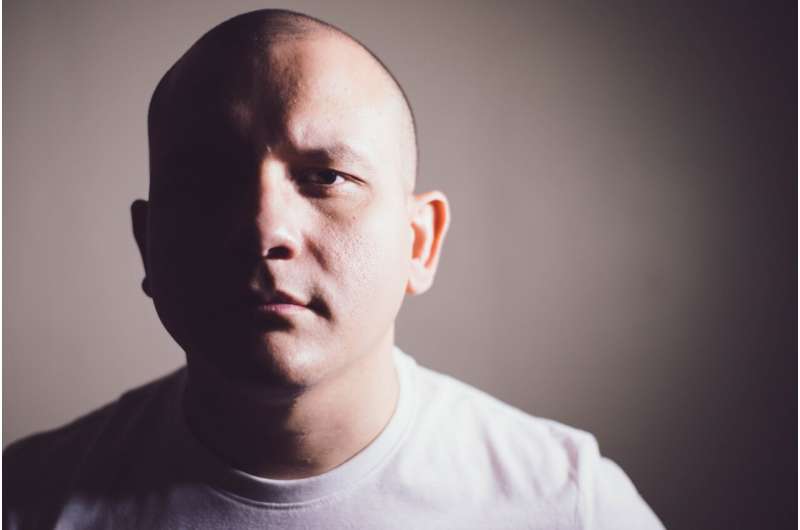This article has been reviewed according to Science X's editorial process and policies. Editors have highlighted the following attributes while ensuring the content's credibility:
fact-checked
peer-reviewed publication
reputable news agency
proofread
Hairy moles may provide antidote for baldness, UCI researchers find

The guy whose naked skull is pale and shiny—save that discolored mole shaped like Cuba near his ear, which inexplicably bristles with hair—may harbor an antidote to baldness.
Researchers at the University of California, Irvine say they've zeroed in on the molecule responsible for hair strands sprouting from moles like that. Their peer-reviewed study, published June 21 in the respected scientific journal Nature, is being touted as a major baldness breakthrough.
"This is a game changer for hair loss for a couple of reasons," said Maksim Plikus, professor of developmental and cell biology at UCI and study lead.
"Instead of studying only mouse fur—research in this area is usually done with mouse fur—we said, 'Enough of that. Let's look at human hair. The solution to human hair loss is in humans.'"
Millions of people have skin growths—"nevi," in scientific-speak—with hair growing out of them, "a really cool experiment that nature created itself," he said.
"We looked at these hairy moles and were weird enough to care about them," Plikus said. "Why is hair growing? We totally didn't know. It was one of those medical mysteries. It takes people who look at the weird things and say, 'Why is that?'"
Over some 10 years of work, the researchers identified a chemical released by a mole's pigmented cells that "potently stimulates hair follicle stem cells for robust hair growth." That molecule is osteopontin.
It was super hard to pin down, Plikus said, but reverse-engineering eventually bore fruit. Or hair, if you will.
"Dermatologists, hair biologists and our patients have long recognized that some nevi induce luxurious hair growth, and this article elegantly demonstrates a novel mechanism for this phenomenon," Dr. Luis Garza, professor of dermatology at Johns Hopkins School of Medicine, said by email. He was not involved with the research.
"After careful animal testing and human trials—that could take years—this work could lead to new medications that help patients with hair loss," Garza said.
How it works
A critical difference between a hairy mole and adjacent skin (with short hairs) is that the moles contain those aforementioned pigmented cells. They're older cells, done dividing. The science-speak for them is "senescent."
Now, senescent cells are often viewed as, you know, sort of useless—detrimental to regeneration, driving the aging process. But this research shows the old dog can do some cool tricks.
These senescent cells don't just sit there taking up space. They "linger around and secrete a bunch of stuff," as Plikus put it. "They use molecular language—you can't shut them up. They keep talking talking talking, communicating with non-aged cells, including stem cells."
The bit of molecular language that's important here is the aforementioned osteopontin, which apparently tells target stem cells to go full Rapunzel. The secreted osteopontin interacts with a molecule on the stem cells called CD44, apparently flipping the hair-growing switch to "gonzo."
Plikus envisions a next-generation medicine that can trigger massive hair growth delivered via microinjection to scalps, say, once every six months or so. Sort of on a Botox schedule.
The researchers plan to study other molecules to fully understand what's going on, and see if there are other potential pathways to hair regrowth. In addition to the team at UCI, research partners hail from all over the place, including China, France, Germany, Korea, Japan and Taiwan.
Commerce
You may recall Plikus and the crew from their research from last year, which likened seemingly-dead hair follicles to a sea of sleeping 3D printers, just waiting for the command to power up. They figured out how to issue that command—by micro-injecting a protein that sounds a bit like "Scooby Doo" into mice.
"Our results identify SCUBE3 as a hair-growth activator," said their paper, published in the journal Developmental Cell. "When microinjected for 4 days … recombinant human SCUBE3 induced significant hair growth in mouse back skin."
To suggest that there's enormous commercial potential here is an obscene understatement. More than 80% of men and nearly half of women will have significant hair loss during their lifetime, according to New York University's Langone Health.
UCI's Plikus is also co-founder of a private, clinical-stage biopharmaceutical company called Amplifica Holdings Group. Amplifica has an exclusive licensing agreement with The Regents of the University of California covering these inventions, and is readying pre-clinical and clinical trials to assess their safety and tolerability.
Amplifica has administered osteopontin to human hair follicles in skin grafts, inducing new growth by human hair follicles, the company's president and CEO Frank Fazio said.
Fazio has spent 30 years in the aesthetics market, including as a core team member for Juvéderm, the popular hyaluronic acid dermal filler that plumps up skin, thus reducing wrinkles. He has seen a lot of excitement, but not quite like this, he said.
In the first 24 hours after the Nature paper was published, he got hundreds of phone calls from people wanting to participate in clinical trials, he said. They've been surprisingly candid about their hair loss "journey," what they've been trying to do to correct course, and why they're looking for a solution, he said.
"It's remarkable," Fazio said.
This work was supported in part by grants from the LEO Foundation, Chan Zuckerberg Initiative, W.M. Keck Foundation, National Science Foundation, National Institutes of Health, the Simons Foundation and California Institute for Regenerative Medicine Shared Research Laboratory.
"It's inspired by true human biology," Plikus said. "Not every mole grows hair—yet another one of nature's secrets. Even more information will come when we start comparing hairy and hairless moles."
More information: Xiaojie Wang et al, Signalling by senescent melanocytes hyperactivates hair growth, Nature (2023). DOI: 10.1038/s41586-023-06172-8
2023 MediaNews Group, Inc. Visit ocregister.com. Distributed by Tribune Content Agency, LLC.





















